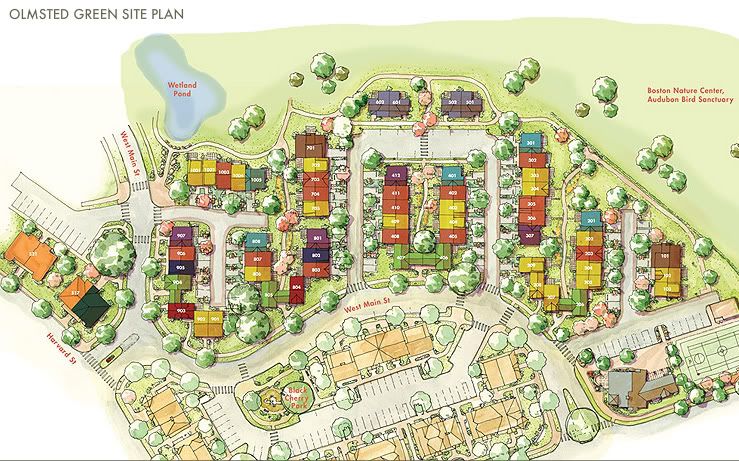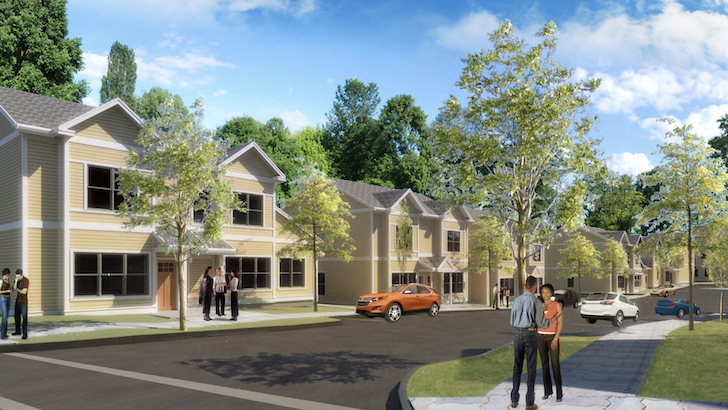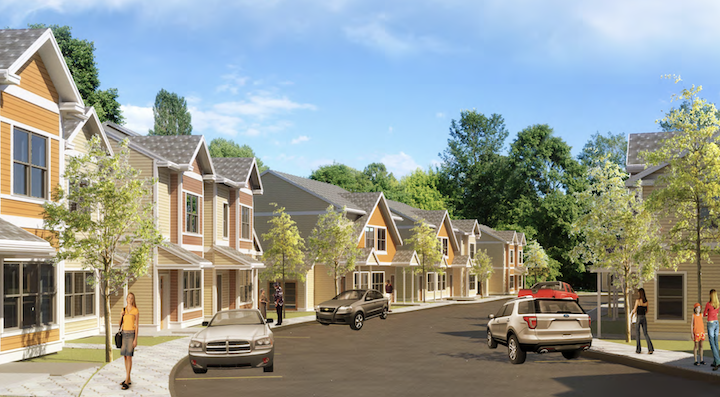BOSTON ? On the long-neglected site of a state mental hospital that closed more than two decades ago, a mixed-income community is under construction.
The development on 42 acres in southwestern Boston is the equivalent of adding a new neighborhood the size of the North End, a rare opportunity in an urban setting that is mostly built up.
The site is at the end of the string of parkland known as Boston?s ?emerald necklace.? It is near Franklin Park, Boston?s largest park, which is almost the size of Prospect Park in Brooklyn; both were designed by Frederick Law Olmsted.
Many of the homes at the development, called Olmsted Green, after the landscape designer, have views of land that was once part of the mental hospital site and is now a nature preserve.
The site, which is in the middle of the neighborhoods of Dorchester, Roxbury and Mattapan, had long been considered ?on the wrong side of the tracks.? Until recently most of the land has been unused, apparently considered a risky venture by private developers.
But now the site is being transformed by an unusual partnership of the Lena Park Community Development Corporation, a small neighborhood nonprofit organization with little experience in real estate, and New Boston Fund, a $1 billion profit-making company that has built 20 million square feet of commercial property and nearly 7,000 housing units nationwide.
When the project is completed in three to five years, the $150 million development will have 153 units of affordable and work-force rental housing, 83 units of affordable senior housing, and 287 market rate condominium town houses and apartments (priced from $278,000 to $550,000). There will also be a health and fitness facility; a job-training and education center; child care, youth and senior programs; and even an urban farm.
?This is a special site that I wanted to bring my urban planning background to,? said Jerry Rappaport Jr., chief executive of the New Boston Fund, who holds degrees in city and regional planning from the Kennedy School of Government and the Graduate School of Design at Harvard. ?I thought of it as an uncut jewel in the emerald necklace, so I took a leap that others might not have been able to see.?
The University of Massachusetts built a biologics lab on the former mental hospital grounds, but most the land has gone unused since the hospital closed.
?On a site that has languished for years, finally there?s a well-designed development,? said Edward Marchant, adjunct lecturer at the Kennedy School of Government and consultant on mixed-income housing, who is not affiliated with this project. In neighborhoods in Boston with a significant need for good housing, like this one, ?when you have a site that can accommodate density and can be achieved through good design, it?s a great opportunity.?
The governor of Massachusetts, Deval L. Patrick, came to the ribbon-cutting on Olmsted Green?s first rental housing in May. More important, Olmsted Green is a model for a bill that the governor signed last week authorizing $1.275 billion worth of bonds ? the state?s largest investment ever in housing and community development projects throughout the commonwealth, according to Tina Brooks, an under secretary in the office of housing and economic development.
?Olmsted Green is a model for going into areas that have faded and reinventing them,? Ms. Brooks said. ?The governor doesn?t just see this as a housing project, but the redevelopment of a neighborhood.?
The formula for building a truly mixed-income, sustainable development where there is no discernible difference between market rate and affordable units seems to reflect a partnership between a profit-making developer and a neighborhood development corporation with deep roots in the community. While the New Boston Fund brought its development expertise, the Lena Park Community Development Corporation has credibility in the community and access to subsidies.
By working with a community development corporation, Mr. Rappaport could jump-start a process that might otherwise have taken many years of enlisting support in the neighborhood and many more to qualify for subsidies.
Still, Mr. Rappaport said, New Boston Fund ? a full-service real estate acquisition, development, management and investment firm ? invested $4 million before zoning and plans were approved. He was able to do this through the Urban Strategy America Fund, a New Boston subsidiary that invests under what it calls the ?triple bottom line model.? The fund seeks not only to generate returns for investors, but also to spur economic development and promote environmental sustainability.
To achieve those ends, the developer says there are more minority contractors working on the site than at any other development in Boston.
Olmsted Green has parking for one car for each unit, supplemented by shared parking spaces and free shuttles to nearby transit stops.
The homes are also energy efficient and clustered for more efficient land use. Olmsted Green?s standard green features include Energy Star rated appliances, carpets and paints with low toxicity, and energy-efficient windows and insulation.
Working with the nature preserve, run by the Audubon Society, the developers will create several walking trails throughout the site. They are also preserving mature trees.
?I grew up in the projects,? said E. Lorraine Baugh, chief executive of the Lena Park Community Development Corporation. ?People want some green and open space, and they don?t want to drive an hour and a half to be able to afford it.?
The nonprofit status of Lena Park qualified the project for state and local subsidies, which enable the developers to build so much affordable housing. In turn, Lena Park will reap substantial benefits from the profit-making development, including an expansion and rebuilding of its community center, and financing of programs, like job training and home-buyer counseling. Even though Lena Park did not risk any of its own resources, it risked its credibility by partnering with a ?white, downtown developer,? Ms. Baugh said.
?Part of our job is to educate the community,? she said. ?As a community development corporation, without this partnership, we could build an affordable unit here and there, but nothing of this scale. Because we were involved, people came in skeptical but not completely opposed.?
But even a well-planned development is not immune from the vagaries of the real estate market. The developer has had to postpone construction of some of the condominiums because of the subprime mortgage crisis and the resulting credit squeeze.
While 50 of the affordable rental units have been built, only 19 of the units that will be sold are near completion, with seven under contract. The second phase is to start later this year.
?In a challenging market, we?re going forward,? said Kirk A. Sykes, president of the Urban Strategy America Fund.





































